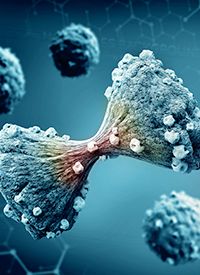News
Article
Long-Term ADT Plus High-Dose Radiation Provides Survival Advantage in High-Risk Prostate Cancer
Author(s):
Long-term androgen deprivation therapy plus radiation therapy led to survival benefits without increased toxicity in high-risk prostate cancer.
Long-Term ADT Plus High-Dose Radiation
in Prostate Cancer | Image Credit:
© Giovanni Cancemi - stock.adobe.com

The use of long-term androgen deprivation therapy (ADT) plus 80 Gy of radiation therapy led to progression-free survival (PFS), cancer-specific survival, and overall survival (OS) benefits without increased toxicity vs long-term ADT plus 70 Gy of radiation therapy in patients with high-risk prostate cancer, according to long-term findings from the phase 3 GETUG-AFU 18 trial (NCT00967863) that were presented during the 2024 ASCO Genitourinary Cancers Symposium.
“Even if we use a long-term ADT, high-dose radiotherapy [80 Gy] improves PFS, cancer-specific survival, and OS, compared to a [standard dose of] 70 Gy, in [patients with] high-risk prostate cancer without increasing toxicity,” Christophe Hennequin, MD, PhD, Department of Radiation Oncology, Saint-Louis Hospital, Paris, said during a presentation of the data.
After a median follow-up of 114.2 months (95% CI, 112.5-116.5), the 5-year biochemical or clinical PFS rates in the 80 Gy (dose escalation) and 70 Gy (control) groups were 91.4% (95% CI, 87.0%-94.4%) and 88.1% (95% CI, 83.2%-91.6%), respectively, while the 10-year rates were 83.6% (95% CI, 77.8%-88.0%) and 72.2% (95% CI, 65.3%-78.0%). The dose-escalation of radiotherapy reduced the risk for disease progression by 44% (HR, 0.56; 95% CI, 0.40-0.76; P = .0005).
When evaluating cancer-specific survival in the dose escalation and control groups, the 5-year (98.7% [95% CI, 96.2%-99.6] vs 96.6% [95% CI, 93.3%-98.3%], respectively) and 10-year (95.6% [95% CI, 91.7%-97.7%] vs 90.0% [95% CI, 84.1%-93.8%]) rates continued to demonstrate superiority with the 80-Gy dose (HR, 0.48; 95% CI, 0.27-0.83; P = .0009).
Lastly, the dose-escalation arm showed a 5-year OS rate of 93.4% (95% CI, 89.5%-95.9%), compared with 88.7% (95% CI, 84.0%-92.0%) with the control arm, as well as 10-year OS rates of 77.0% (95% CI, 70.2%-82.4%) and 65.9% (95% CI, 58.7%-72.1%), respectively, reducing the risk for death by 39% (HR, 0.61; 95% CI, 0.44-0.85; P = .0039).
Hennequin noted that there was no difference between arms regarding toxicity and quality of life. Grade 3 or higher late genitourinary toxicities occurred in 20.6% of the high-dose arm, vs 19.9% in the control arm, while 1.6% of patients in each arm experienced a grade 3 or higher late digestive toxicity.
Hennequin noted that a variety of randomized trials have been conducted to evaluate the role of de-escalation in prostate cancer. “Most of them demonstrated an improvement in biochemical control, but no demonstrated benefit in overall survival. However, most of these trials included a low number of high-risk patients, and most of [the patients] did not choose long-term ADT. They used no ADT or short-term ADT,” he added, also acknowledging that long-term ADT is the standard of care in this patient population.
“The question remains: Is it necessary to increase the dose of radiotherapy in case of long-term ADT, or is the standard dose good enough for this patients?” Hennequin said.
Therefore, in the randomized phase 3 trial, high-risk patients were randomized 1:1 to receive either dose-escalated (80 Gy) or conventional-dose (70 Gy) radiotherapy plus 3 years of ADT to determine the efficacy and safety of dose escalation in combination with long-term ADT.
To be eligible for the trial, patients had to have high-risk prostate adenocarcinoma, with 1 of 3 factors (PSA ≥ ng/ml, Gleason ≥ 8, or cT3-T4) and a performance score of 0 to 2. Key inclusion criteria included histologically-proven prostate adenocarcinoma; disease of the unfavorable group defined by T3 or T4 clinical stage, Gleason score or serum PSA level; lymphatic dissection or cN0 ≥ 15 mm on CT or MRI; absence of bone or visceral metastases; hormone treatment beginning no later than the day of radiotherapy and no earlier than 6 months before irradiation; absence of prior pelvic radiotherapy; absence of surgical treatment for prostate cancer, except transurethral resection performed at least 3 or 4 months previously; aged 18 to 80 years; ECOG performance status of 1 or less; and life expectancy of more than 5 years.
Investigators stratified patients by lymph node resection and institution.
PFS served as the trial’s primary end point, while secondary end points included cancer-specific survival, OS, and late toxicity. In the updated evaluation of the trial, 6-year biochemical or clinical PFS was the primary end point; OS, specific survival, acute and delayed toxicities, and quality of life were the secondary end points; and exploratory end points included clinical relapse-free survival and metastasis-free survival.
In total, 505 patients from across 25 French centers were recruited from June 4, 2009, to January 24, 2013. Patients were a median age of 71 years (range, 52-80), with the majority reporting with just 1 high-risk disease factor (64.6%). Further, 16.4% of patients received lymph node dissection.
Median duration for ADT was 33.4 months, while 82.9% of patients underwent pelvic lymph node radiation, and 6 patients did not have radiotherapy performed. Interestingly, according to Hennequin, 80.6% of the dose-escalation arm received intensity-modulated radiation therapy (IMRT) in addition to ADT (P < .001).
“Obviously IMRT is required to obtain these results. So, we have now level 1 evidence that high-dose [radiotherapy] with long-term ADT must be the standard of care in high-risk prostate cancer patients,” Hennequin concluded.
Reference
Hennequin C, Sargos P, Roca L, et al. Long-term results of dose escalation (80 vs 70 Gy) combined with long-term androgen deprivation in high-risk prostate cancers: GETUG-AFU 18 randomized trial. J Clin Oncol. 2024;42(suppl 4). Abstract LBA259.






%20(2)%201-Recovered-Recovered-Recovered-Recovered-Recovered.jpg?fit=crop&auto=format)

%20(2)%201-Recovered-Recovered-Recovered-Recovered-Recovered.jpg?fit=crop&auto=format)
%20(2)%201-Recovered-Recovered-Recovered-Recovered-Recovered.jpg?fit=crop&auto=format)